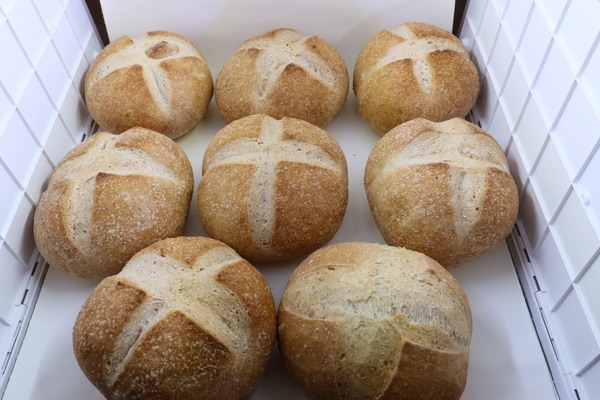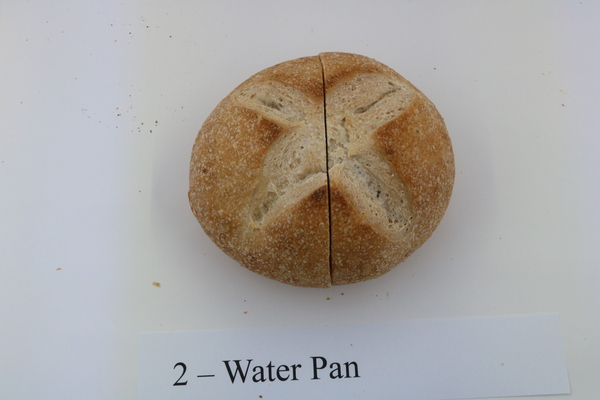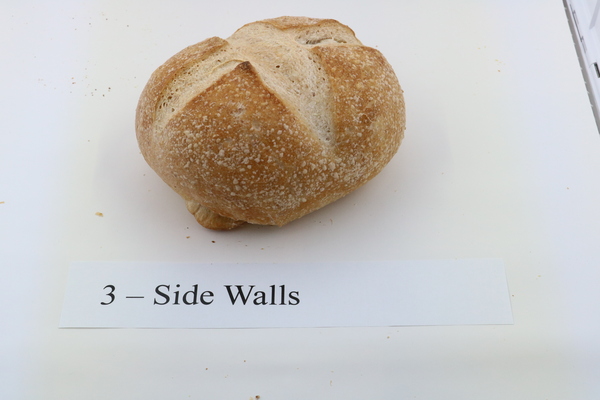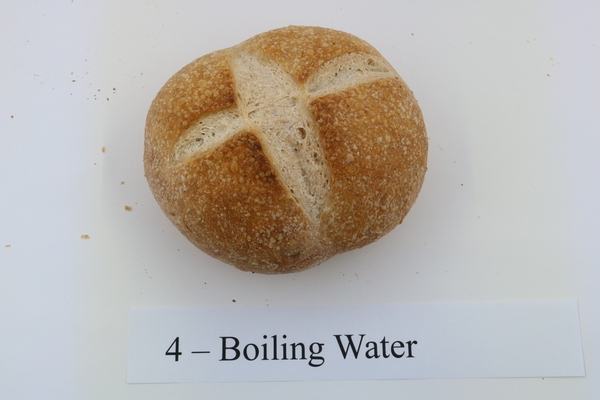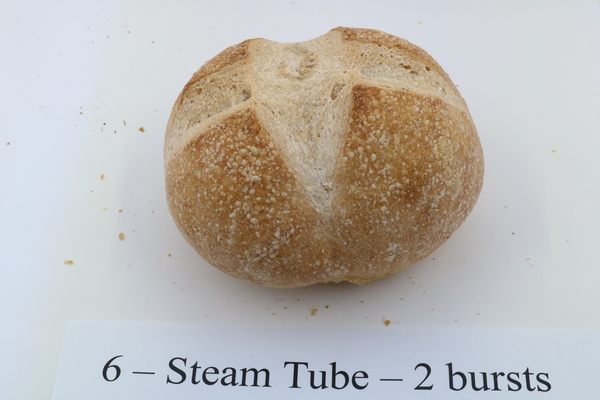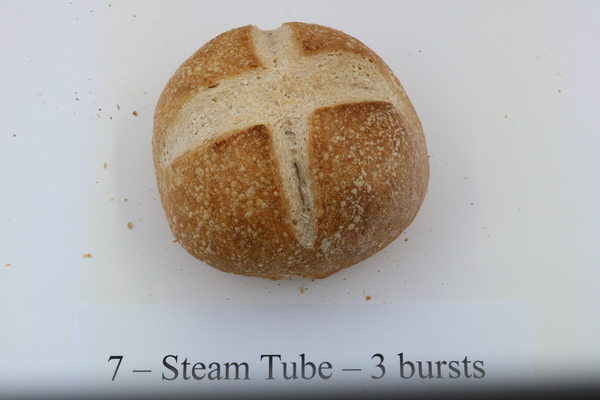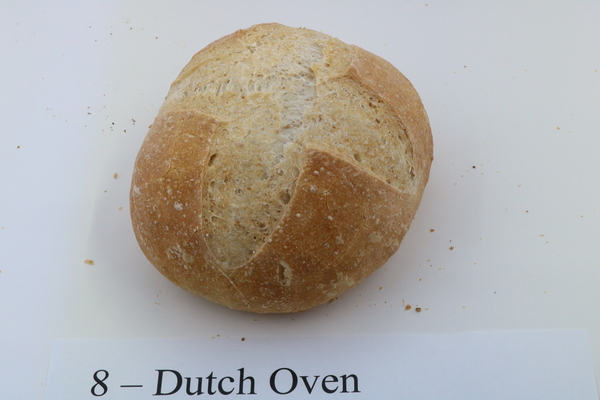Home › Forums › Baking — Breads and Rolls › Adventures in Steam
- This topic has 57 replies, 11 voices, and was last updated 5 years, 10 months ago by
BakerAunt.
-
AuthorPosts
-
February 18, 2020 at 9:04 pm #21446
That Challah is picture perfect!
February 19, 2020 at 8:47 am #21451Pretty amazing challah. I've made a double decker one once. It is not easy.
February 19, 2020 at 10:16 am #21453I agree, it's amazing and beautiful!
February 19, 2020 at 10:20 am #21455Steam Test Photos
Well, the steam test took about 12 hours, but I learned quite a lot, not all of it about steaming bread. 🙂
Here's a group photo of the 8 loaves I baked, followed by a shot of each one of them, with comments. The group shot shows them in order left to right, back to front.
Each of the loaves is 12 ounces of Pain de Campagne from the Bread Baker's Apprentice. The boules were just under 4 inches in diameter after shaping and 5 to 5 1/2 inches in diameter after baking.
Here's the 'control', a loaf made with no steam. The surface is relatively smooth.
This test had a pan of water in the oven during the pre-heat cycle, removed at the 10 minute mark.
For this test I sprayed the side walls 3 times during the first 3 minutes of baking. This is the method I've been using for the past several years.
This test had a cast iron skillet in the oven during preheat, and I added a cup or so of boiling water when the loaf went in the oven. The pan came out at the 10 minute mark.
This is the first test with my steam tube setup, I put in 20 CCs of water.
This is the second test with my steam tube, I put in a total of 40 CCs of water in two bursts about 2 minutes apart.
This is the third test with my steam tube, I put in a total of 60 CCs of water in three bursts about 2 minutes apart. All of the water had evaporated by the 10 minute mark.
This test was done in a round Dutch Oven, with the lid on for the first 15 minutes.
What did I learn?
Looking at the 8 loaves, the ones I liked best were 3 (side walls), 4 (boiling water) and 7 (steam tube, 3 shots of steam.) I think the overall winner is the steam tube setup with 3 shots of steam, but the boiling water one is a surprisingly close second, I think that's the method I'd recommend most people use. Although a lot of the steam goes out the open oven door, apparently there's enough of it to do a decent job.
I find pouring boiling water from a tea kettle is far easier than other methods I've used, though I did see an interesting suggestion that you use a wine bottle. It accomplishes much the same thing, giving you more control over the process while keeping your hand away from the blast of steam.
The interior shots aren't all that interesting, there really wasn't a lot of difference between them. They were all a bit underdone, I should probably have done a pre-test to establish the total baking time for this size loaf.
I have to say I wasn't all that impressed with the dutch oven one. It probably got the most oven rise, but the surface wasn't nearly as dimpled as the others, it looked a lot like the 'no steam' loaf except for the way the oven rise pretty much filled in the cuts. A lot of people like this method, I may have to try it again.
I did discover a relatively easy and safe way to put the loaf in a Dutch Oven pan. I have a 'cookie spatula' that I got from King Arthur Flour a while back, though I don't think they sell it any more. It is a large offset spatula that is about 6 1/2 inches wide, so I just put it under the parchment the dough was shaped on and lowered it into my Dutch Oven without my hands getting even close to the hot pan.
Attachments:
You must be logged in to view attached files.February 19, 2020 at 10:31 am #21466Those look wonderful. I'd gladly eat any of them. How big are they? Like a softball? They look like a group of hot cross buns but with cut crosses instead of frosting.
February 19, 2020 at 10:43 am #21467I just finished editing the post, I think most of your questions are answered now. (BBPress only lets you add 4 photos at a time, so it was visible before I could add most of my comments.)
February 19, 2020 at 3:16 pm #21469Mike. Pretty cool. Thanks for this. I want to make a steam tube!
What was the difference between starting weight and finishing weight? Was it significant? I don't usually care but when I taught challah making the finished loaf size mattered. I needed about 18.5 ounces to make a one pound loaf.
I've just started to notice the different weights before and after proofing, after second rise, and after baking and I have been curious.
February 19, 2020 at 4:16 pm #21470Thanks for the photos and update on your bread tests,#7 is my pick.
February 19, 2020 at 4:25 pm #21472The loaves started out at 12 ounces and finished at around 11 ounces. I didn't weight them just before they went into the oven.
I did notice that the 51 ounces of pate fermentee lost about 2 ounces in the refrigerator overnight.
February 19, 2020 at 4:30 pm #21473Interesting. Thanks
February 19, 2020 at 5:04 pm #21474Hi Mike, saw your link from the BBGA list (I was the original poster on that thread). Bravo on the systematic test!
I assume you have an electric oven? My gas oven vents out the front like crazy so I've never had any luck with any method but covered baking. My new oven will be electric, although it's expensive enough that I will probably be afraid to do any of these steaming methods, so will likely stick with covered baking, ha.
In my experience a cast iron dutch oven can produce a darker, crisper crust than your test loaf, if preheated at high temperatures (at least 450 F) long enough (at least 45 minutes). Keeping the bottom from burning gets tricky, although I've solved that by putting a sheet pan below the DO on the rack just below it -- seems to shield the DO from some of the heat from the oven floor.
Eric
February 19, 2020 at 5:46 pm #21475Thanks for posting, Eric, and welcome to MNK.
The Dutch oven pan was preheated at 450 for probably somewhere between 30 and 40 minutes. I didn't show the bottoms of any of the loaves, the one in the Dutch oven was the only one that was starting to show signs of scorching on the bottom, in part because the only way I can fit my Dutch oven pan in my oven is on the bottom shelf. Adding a pan to insulate it from the lower element a bit (yes, it is an electric oven) might help. I've got a couple of recipes that I have to double-pan to keep the bottoms from getting scorched before the top gets done.
All of the loaves suffered from being a little under-baked in the center, somewhat intentionally, because I pulled them all at the point where the top was showing a little dark brown. They probably needed another 5 minutes to be fully baked in the center, and that would have affected how dark they got, but it might also have made it harder to see the impact of the steam method. Lesson learned: Do some pre-tests before the production test. (My research methods prof would zing me for that, pre-testing your instrument was something he emphasized over and over.)
I will try the Dutch oven idea again, but for now my steam tube is working reasonably well. I did some baguettes with it today to test some triticale flour, I'll be doing more triticale tests over the next few weeks. (First lesson learned from triticale: It gets dark faster and can get scorched quickly.)
I did put the loaves back in the oven last night to get them a little more baked. The only complaint my wife got about the bread today was, "What, no butter?"
February 20, 2020 at 8:32 am #21492Fascinating experiments, Mike.
I've never tried a Dutch oven bread, although I have Dutch ovens, and an Emile Henry round ceramic pot (the first one that KAF sold years ago) that I've yet to try. The latter is supposed to rise in the pot then be put into the oven; I think that I also saw a recipe that puts it in a cold oven and starts from there.
I have an Emile Henry long baker, and I like how that one bakes, as long as I take the lid off after the initial baking period. Most of my breads in regular pans seem to do better if spritzed with water before baking than when I just put them in without doing so.
February 20, 2020 at 8:47 am #21493I like the bread I get from my long covered baked, similar to one that KAF sells. It is clay, no enamel coating. I spritz it with water before it goes in the oven, and that yields a nice crisp crust. I do remove the cover for the last 10 minutes of baking to brown it. I would never have the patience to go through all that Mike is doing for his steam experiment!
February 20, 2020 at 12:13 pm #21494I bake using a cold Dutch Oven it seems so much safer than trying to handle the hot cast iron. I've also tried a clay coche over my bread and I like the results. The bread seems to rise higher and has a thinner crust. Has anyone tried baking in a thinner covered pan, like a small roasting pan? I'm wondering if the good results come from using a closed container, or from using a container with a relatively high thermal mass.
-
AuthorPosts
- You must be logged in to reply to this topic.
